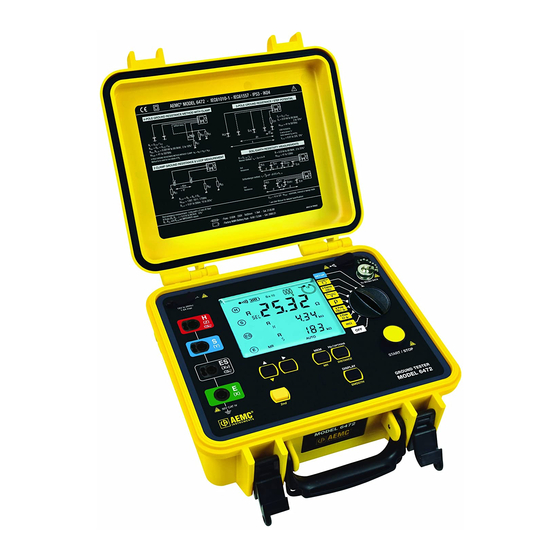Advertisement
Table of Contents
Issue 09
Featured Product:
Performing a Wenner Soil Resistivity
Test with the AEMC
S
oil resistivity is a key factor for determining what the resistance of a grounding
electrode will be, to what depth it must be driven in order to obtain low earth
resistance, and even the type of grounding system that should be designed for
this location and facility.
The resistivity of the soil varies widely throughout the world and changes
seasonally. Resistivity is strongly affected by the content of electrolytes in the
soil, its moisture content, and even its temperature. Soil resistivity measurements
are therefore critical for designing and constructing a grounding system
appropriate for your site and requirements.
This article describes a simple way to measure soil resistivity known as the
Wenner method. Our test instrument will be the AEMC
6472. This instrument automatically calculates and displays soil resistivity, with
no manual calculations necessary.
The Model 6472 also features advanced capabilities such as test currents up
to 250 milliamps for testing soils with high resistivity, automatic test frequency
selection for testing in high EMI environments, and the ability to connect to a
computer via AEMC's DataView
2
"WATTS CURRENT" TECHNICAL BULLETIN
data analysis software.
®
Soil Resistivity vs Resistance
In this article, we refer to both soil resistivity and soil
resistance. To avoid possible confusion, it's important to
have a basic understanding of what these terms mean
and how they differ. Simply put, resistance (represented
by the letter R) is a property of a specific physical
item of a definite size and shape; while resistivity
(represented by the Greek letter
property of a material irrespective of its shape or size.
For example, a 500-foot length of 10-gauge copper
wire has a specific resistance, measureable in
ohms (Ω); while copper as a material possesses
a general resistivity, expressed in units such as
ohm-centimeters (Ωcm) or ohm-meters (Ωm).
Changing the length or gauge of the wire
changes its resistance, while the resistivity of
the copper from which it is made remains the
same.
Model 6472
®
Ground Tester Model
®
ρ
), is a general
Summer 2016
Advertisement
Table of Contents

Summary of Contents for AEMC 6472
- Page 1 6472. This instrument automatically calculates and displays soil resistivity, with no manual calculations necessary. The Model 6472 also features advanced capabilities such as test currents up to 250 milliamps for testing soils with high resistivity, automatic test frequency selection for testing in high EMI environments, and the ability to connect to a computer via AEMC’s DataView...
- Page 2 The two inner electrodes (called the potential electrodes) measure voltage, which is then used to calculate soil resistance. The Model 6472 automatically calculates soil resistivity using a formula that assumes the auxiliary electrodes are inserted into the ground to a depth that does not exceed 1/20th of the spacing distance between electrodes.
- Page 3 “WATTS CURRENT” TECHNICAL BULLETIN Issue 09 Summer 2016 To enable the instrument to accurately calculate soil resistivity, we must enter the electrode spacing distance. We start by ensuring the instrument is configured for the correct units of measure. Turn the instrument’s dial to the set-up setting. Then press the DISPLAY button. The unit of measure, either meters (m) or feet (ft), appears blinking on the screen.
- Page 4 DataView for further ® analysis. This concludes our quick explanation of how to perform a Wenner soil resistivity measurement with the Model 6472. For more information about this instrument, please visit our Product Page...
















Need help?
Do you have a question about the 6472 and is the answer not in the manual?
Questions and answers